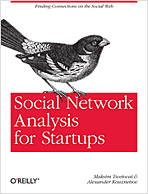Social networking has become a pervasive part of our everyday online experience, and by extension, that means the analysis and application of social data is an essential component of business.
In the following interview, “Social Network Analysis for Startups” co-author Maksim Tsvetovat (@maksim2042) offers a primer on social network analysis (SNA) and how it has relevance beyond social-networking services.
What is social network analysis (SNA)?
Maksim Tsvetovat: Social network analysis is an offshoot of the social sciences — sociology, political science, psychology, anthropology and others — that studies human interactions by using graph-theoretic approaches rather then traditional statistics. It’s a scientific methodology for data analysis and also a collection of theories about how and why people interact — and how these interaction patterns change and affect our lives as individuals or societies. The theories come from a variety of social sciences, but they are always backed up with mathematical ways of measuring if a specific theory is applicable to a specific set of data.
In the science world, the field is considered interdisciplinary, so gatherings draw mathematicians, physicists, computer scientists, sociologists, political scientists and even an occasional rock musician.
As far as the technology aspect goes, the analysis methods are embodied in a set of software tools, such as the Python-based NetworkX library, which the book uses extensively. These tools can be used for analyzing and visualizing network data in a variety of contexts, from visualizing the spread of disease to business intelligence applications.
In terms of marketing applications, there’s plenty of science behind “why things go viral” — and the book goes briefly into it — but I find that it’s best to leave marketing to marketing professionals.
Does SNA refer specifically to the major social-networking services, or does it also apply beyond them?
Maksim Tsvetovat: SNA refers to the study of relationships between people, companies, organizations, websites, etc. If we have a set of relationships that may be forming a meaningful pattern, we can use SNA methods to make sense of it.
Major social-networking services are a great source of data for SNA, and they present some very interesting questions — most recently, how can a social network act as an early warning system for natural disasters? I’m also intrigued by the emergent role of Twitter as a “common carrier” and aggregation technology for data from other media. However, the analysis methodology is applicable to many other data sources. In fact, I purposefully avoided using Twitter as a data source in the book — it’s the obvious place to start and also a good place to get tunnel vision about the technology.
Instead, I concentrated on getting and analyzing data from other sources, including campaign finance, startup company funding rounds, international treaties, etc., to demonstrate the potential breadth of applications of this technology.
 Social Network Analysis for Startups — Social network analysis (SNA) is a discipline that predates Facebook and Twitter by 30 years. Through expert SNA researchers, you’ll learn concepts and techniques for recognizing patterns in social media, political groups, companies, cultural trends, and interpersonal networks.
Social Network Analysis for Startups — Social network analysis (SNA) is a discipline that predates Facebook and Twitter by 30 years. Through expert SNA researchers, you’ll learn concepts and techniques for recognizing patterns in social media, political groups, companies, cultural trends, and interpersonal networks.How does SNA relate to startups?
Maksim Tsvetovat: A lot of startups these days talk about social-this and social-that — and all of their activity can be measured and understood using SNA metrics. Being able to integrate SNA into their internal business intelligence toolkits should make businesses more attuned to their audiences.
I have personally worked with three startups that used SNA to fine-tune their social media targeting strategies by locating individuals and communities, and addressing them directly. Also, my methodologies have been used by a few large firms: the digital marketing agency DIGITAS is using SNA daily for a variety of high-profile clients. (Disclosure: my startup firm, DeepMile Networks, is involved in supplying SNA tools and services to DIGITAS and a number of others.)
What SNA shifts should developers watch for in the near future?
Maksim Tsvetovat: Multi-mode network analysis, which is analyzing networks with many types of “actors” (people, organizations, resources, governments, etc.). I approach the topic briefly in the book — but much remains to be done.
Also, watch for more real-time analysis. Most SNA is done on snapshot-style data that is, at best, a few hours out-of-date — some is years out-of-date. The release of Twitter’s Storm tool should spur developers to make more SNA tools work on real-time and flowing data.
This interview was edited and condensed.
Associated photo on home and category pages: bulletin board [before there was twitter] by woodleywonderworks, on Flickr.
Related:
